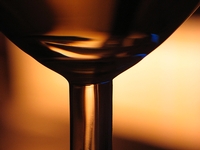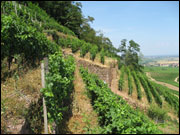When people regard something that lies outside the cultural mainstream as peerlessly beautiful, it often bothers them that others don’t appreciate it more fully. All of us have friends who feel this way about certain little-known books, works of art or pieces of music. And when friends scold us for not being properly enamored with one of their beloved objects, we’re usually able to take our scolding with a smile, knowing that we’re only being chided because our friend wants us to share in something wonderful.
I hope my friends keep that notion in mind when I reproach them for not appreciating Alsace Riesling adequately. My belief is that it is the most lamentably under-appreciated of France’s best wines, and this bothers me so much that I’ve been badgering friends about it for years. They’ve always taken it graciously, though it probably helps that their scolding is usually served with a glass of delicious wine.
appreciating Alsace Riesling adequately. My belief is that it is the most lamentably under-appreciated of France’s best wines, and this bothers me so much that I’ve been badgering friends about it for years. They’ve always taken it graciously, though it probably helps that their scolding is usually served with a glass of delicious wine.
To claim that Alsace Riesling is the most under-appreciated of France’s greatest wines is really to make two claims, one regarding the level at which the wine is valued, and another regarding the wine’s virtues.
In this globalized era, the reputation and commercial fortunes of Alsace’s Rieslings are inevitably tied to Rieslings made in Austria, Australia, and especially Germany. All have enjoyed a modest commercial comeback in recent years, yet they remain seriously undervalued around the world. During the late 19th and early 20th centuries, top Rieslings were prized--and priced--as highly as the best bottlings of Burgundy and Bordeaux. Today, Riesling no longer plays in that prestigious league, and even among white wines, sales consistently lag behind Chardonnay, Sauvignon Blanc and Pinot Gris/Grigio.
This is not a consequence of any decline in quality. I’m confident that most experts would agree that the Rieslings produced around the world during the past 20 years are the best ever made. Riesling’s problems lie elsewhere, namely, in the fickle arena of fashion.
Trends in vinous fashion have been running in a drier direction for decades, and Riesling, like Port, has suffered as a consequence. This is unfortunate in both cases but especially unfair for Riesling, which need not be sweet at all, and is usually dry except for renditions made in Germany. Even German Rieslings have been getting drier on average during the past 15 years. However, Riesling hasn’t been able to shed the stigma of reputed sweetness, with leads many consumers to the mistaken conclusion that it is an old-fashioned dessert wine, ill-suited to use as an aperitif or as a partner for savory foods.
Recent fashions in wine have also favored big, oaky, alcoholic wines. This adds up to three strikes against Riesling, which is almost always lean and light, and is very rarely made with any overt wood notes. Thankfully, the big bruiser fad seems to have peaked, and I see indications of a consumer backlash in the rise of light, fresh Pinot Grigio and explicitly “unoaked” Chardonnay. Sales trends indicate that Riesling is getting a bit of a ride on this wave, and we can hope that it will ultimately regain its proper place, which in my opinion is at the very top of the white wine pyramid.
I consider Riesling the greatest white wine variety because no other grape is so versatile, age-worthy, or capable of conveying the particular character of its place of origin. Riesling can excel as a bone dry wine, an unctuous dessert wine, and at every level of sweetness in between. Excellent examples are remarkably durable, improving for decades when properly cellared. And no other variety--white or red--can match Riesling’s ability to convey the little nuances of soil and climate that give great wines a sense of place.
I would not relish the prospect of being limited to a single geographic source for my Riesling, but if forced to choose, I would choose Alsace. Top Rieslings from Alsace are more complex and age-worthy than their counterparts from Austria and Australia, and whereas most German Rieslings need sweetness to counterbalance their abundant natural acidity, Alsace Rieslings can be harmonious even when made in a bone dry style.
If Alsace Rieslings are therefore--at least arguably--the best of the best among white wines, why aren’t they better known in the wider world? The reputed sweetness issue is part of the answer, but there’s also the problem that the wines are relatively rare. Alsace is the only place in France where wine laws permit plantings of Riesling, and within Alsace, it is only one of seven vine varieties that are grown (the others being Gewurztraminer, Muscat, Pinot Blanc, Pinot Gris, Pinot Noir and Sylvaner).
A novice might mistake Riesling for just another grape in this crowd, but almost every vintner I’ve interviewed regards it as the Alsace’s most  noble variety. Consequently, it is usually treated to prime sites within the region’s vineyards, and it manifests its greatness differently depending on the soils in which it is planted. It shows intensity and firm structure in granite soils, by contrast to a softer, richer profile in clay. Sandy soils produce wines that are light but mineral and elegant, whereas alluvial soils lend more body and lower acidity. Limestone conjures Rieslings that are especially restrained in their youth but supremely intricate and nuanced when mature.
noble variety. Consequently, it is usually treated to prime sites within the region’s vineyards, and it manifests its greatness differently depending on the soils in which it is planted. It shows intensity and firm structure in granite soils, by contrast to a softer, richer profile in clay. Sandy soils produce wines that are light but mineral and elegant, whereas alluvial soils lend more body and lower acidity. Limestone conjures Rieslings that are especially restrained in their youth but supremely intricate and nuanced when mature.
Alsace Riesling can show a remarkable range of aromas and flavors, with fruit notes ranging from apple and citrus to stone fruits, along with accents of flowers, flint, freshly cut grass, fennel and honey. Of course, there’s no substitute for direct experience, so here are brief notes on my six favorite Riesling producers:
Léon Beyer (Eguisheim): Marc Beyer is a 13th generation proprietor of this venerable family firm, and he makes exceedingly complex, impeccably dry Rieslings that are treasured by restaurateurs around the world. All of his Rieslings are lean and steely in their youth, adding depth and dimension with each passing year. The generic Riesling is remarkably consistent. The top bottlings, “Comtes d’Eguisheim” and “Les Ecaillers,” are only made in great vintages, and can improve for two decades.
Albert Boxler (Niedermorschwihr): Boxler is a family firm that crafts some of Alsace’s most exciting wines from grapes drawn entirely from its own 30 acres of vineyards. All Boxler Rieslings are very intense in flavor and are structured with an abundance of racy acidity. The range includes an excellent, generic Riesling, a “Reserve” bottling made from young vines planted in Grand Cru vineyards, and Grand Cru wines from Brand and Sommerberg that are always among the best in Alsace.
Dirler-Cade (Bergholtz): Working 38 acres of vines in a biodynamic manner, this house produces an excellent generic Riesling, a strongly mineral rendition from a lieu-dit called Belzbrunnen, and several extraordinary cuvées from the Grands Crus Spiegel, Saering and Kessler. These Rieslings are open and generously flavored but also seriously structured and capable of long ageing.
F. E. Trimbach (Ribeauvillé): Trimbach Rieslings are uncompromisingly dry. Although they can be bitingly acidic in their youth, they can also mature over decades to develop remarkably complex floral, fruit and mineral notes. The generic Riesling is very serious and consistent. Cuvée Frédérick-Emile is deeper and more concentrated but still quite taut. Clos Ste. Hune is widely regarded as the world’s greatest dry Riesling, and the Clos Ste. Hune Vendange Tardive couples greater richness with astonishing acidic balance.
Domaine Weinbach (Kaysersberg): Weinbach Rieslings have been models of purity and balance for decades, though recently the balance point has moved a bit toward the drier side of the spectrum under the talented guidance of winemaker Laurence Faller. Her Rieslings are all generously flavored despite being only slightly sweet, with Cuvée Théo, Saint-Catherine, and Schlossberg achieving consistent excellence. Schlossberg Cuvée Ste.-Catherine is often a striking wine showing an uncanny combination of restrained focus with profound depth.
Domaine Zind Humbrecht (Wintzenheim): This extraordinary producer makes as many as 10 different Rieslings plus additional Vendenges Tardives and Sélection de Grains Nobles cuvées. Fermentations are performed naturally with wild yeasts, sometimes concluding with quite notable sweetness left in the finished wines. Top Bottlings: Brand, Clos Häuserer, Clos Windsbuhl, Rangen de Thann Clos St.-Urbain.